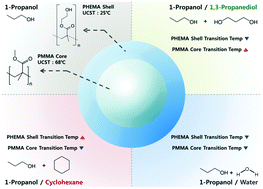A cosolvency effect on tunable thermosensitive core–shell nanoparticle gels†
Abstract
The influence of co-solvents on the swelling behavior of tunable thermosensitive core–shell nanoparticle gels was investigated. The poly(methyl methacrylate) (PMMA) core and poly(2-hydroxyethyl methacrylate) (PHEMA) shell network in 1-propanol reacted differently upon the addition of three co-solvents (cyclohexane (CHX), 1,3-propanediol (PDO), and water), resulting in highly controllable swelling properties of the core–shell gels. In particular, a strongly enhanced solvation effect, called the cosolvency phenomenon, occurred even with a very small amount of water (1–3 wt%). To examine the tunability, thermo-optical analysis (TOA) and photon correlation spectroscopy (PCS) were employed. The results show that a small addition of CHX, PDO, or water induced the “lower/upper,” “even/upper,” and “lower/lower” volume transition temperatures (VTTs) of the core–shell networks, respectively. For theoretical treatment, a multi-component lattice theory of mixing was combined with the Flory–Rehner (F–R) chain model to calculate the net free energy of mixing. The required interaction parameters were obtained from the binary and ternary phase diagrams of the linear polymer solutions and were applied directly to the swelling calculation of the cross-linked core–shell network solutions. The calculated results corresponded well with the experimental swelling data without further adjustment.


 Please wait while we load your content...
Please wait while we load your content...